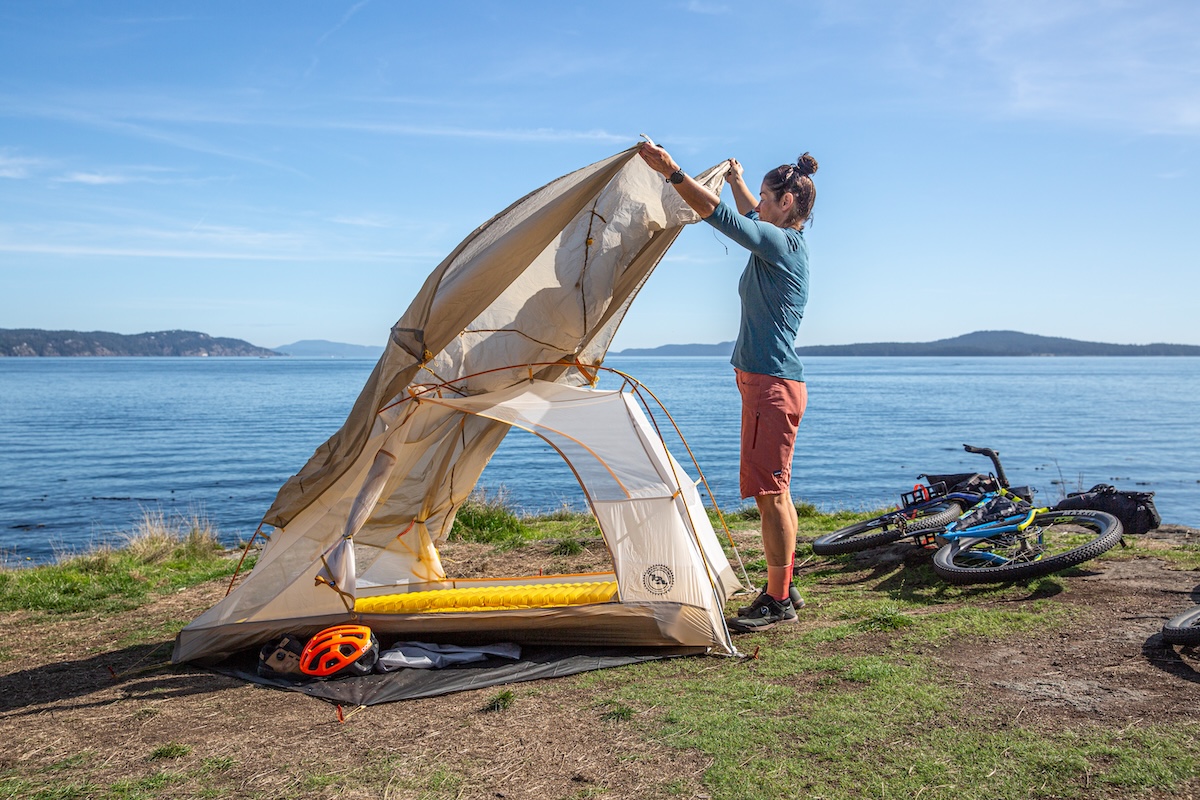
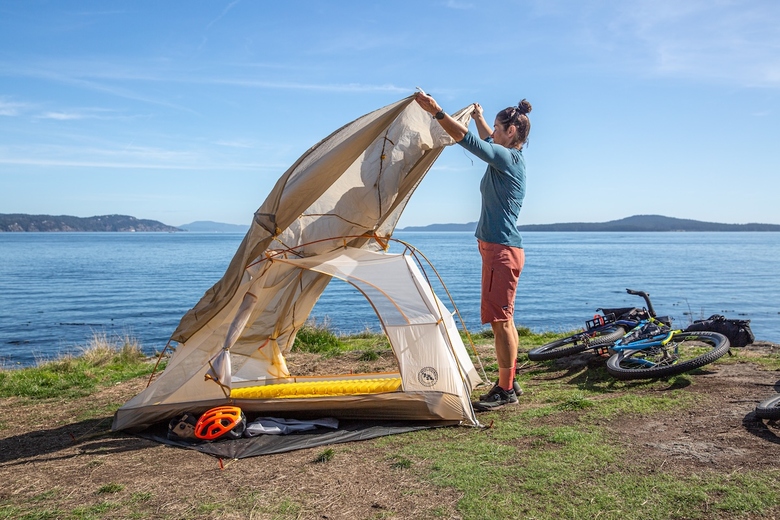
Price: $500
Packaged weight: 2 lb. 15 oz. (2P)
Floor area: 28 sq. ft.
Capacities: 2P, 3P
What we like: Competitive combination of protection, weight savings, and bikepacking-specific features.
What we don’t: Interior feels cramped with two people; heavier than the original Tiger Wall.
See the Big Agnes Tiger Wall UL2 Bikepack
We’ve always been fans of Big Agnes tents, particularly their lightweight, freestanding (or semi-freestanding) models. A few years ago, they introduced three bikepacking versions of their popular backpacking tents: the Copper Spur, Tiger Wall, and Fly Creek. The bikepacking shelters are almost exactly the same as their backpacking counterparts, with the main differences being shorter pole segments for fitting onto your handlebars or in bikepacking bags, as well as bike-specific carry cases. We were eager to take the Tiger Wall UL2 Bikepack on a recent island-hopping adventure, and, overall, we were fans of the tent, but would prefer a slightly roomier version for long endeavors. Below, we outline our experiences with the two-person Big Agnes Tiger Wall UL Bikepack. To see how it stacks up to the competition, check out our articles on the best backpacking tents and best ultralight tents.
The Big Agnes Tiger Wall UL2 Bikepack is a 3-season tent, and it has seen those seasons many times over during our testing time. The vestibules kept our gear protected in bad weather, and the footprint (purchased separately) extends to fit under the vestibules, which kept our gear off wet grass, sand, and mud. The rainfly has substantial zipper garages that can be secured with Velcro tabs, and the pitch is fast enough that you can set it up quickly if a storm rolls in. The Tiger Wall can also be set up using just the footprint and fly over the poles, with the tent body hung from the poles after. This is called the "fast fly" method and can conceivably create a fast shelter in bad weather.
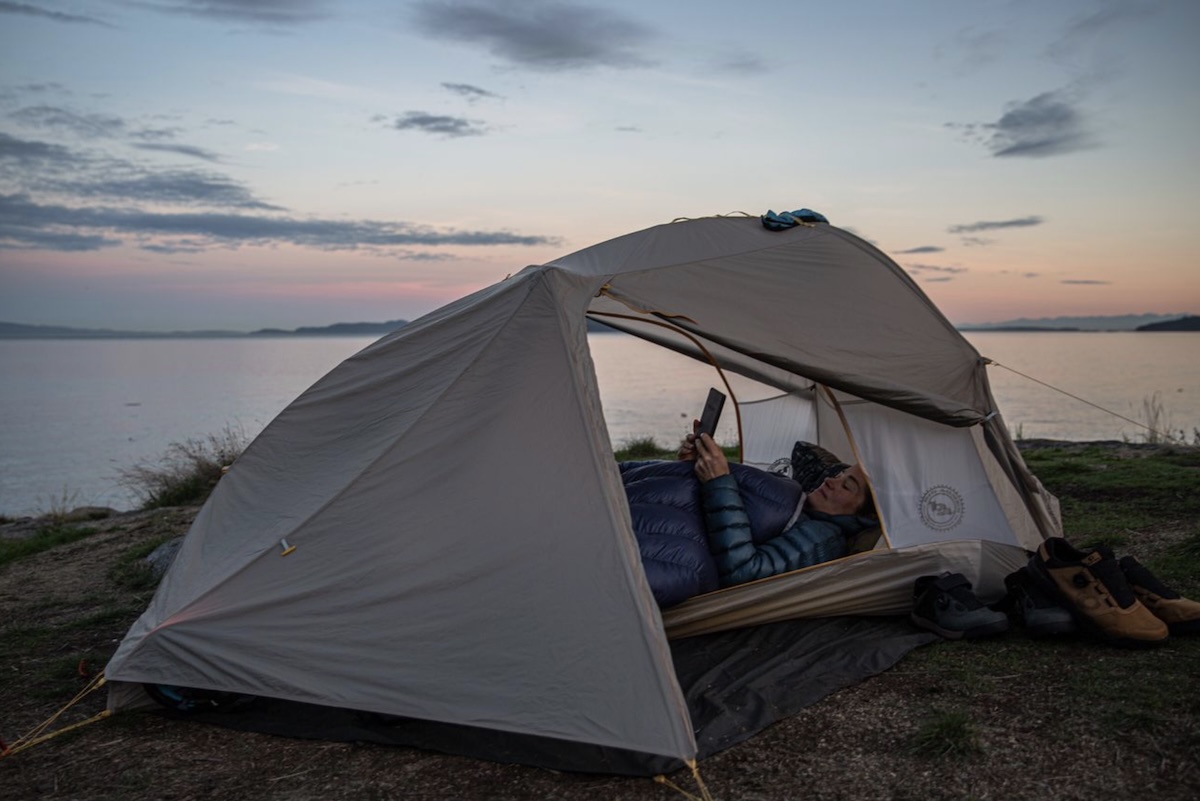
Wind
Since relocating to Vancouver Island, the majority of campsites are on the oceanfront. While these come with amazing views, they also come with high winds, and shelters need to be well staked and tightly pitched. Because the Tiger Wall UL2 Bikepack is a semi-freestanding design, it's helpful to pitch the head wall (the end with two anchor points) towards the wind to better withstand the force. It's also important to attach the fly to the poles with the Velcro tabs, which isn't something we usually do with other shelters. The tent comes with three guyline points, which we recommend using if the winds pick up. The single-anchor pole at the foot of the tent can get blown around a bit, but securely staking the corners helps reduce movement. We've also learned to trust that the poles are designed to flex, so even when the tent was flattened against my partner and me by angry gusts, the Tiger Wall stayed up.
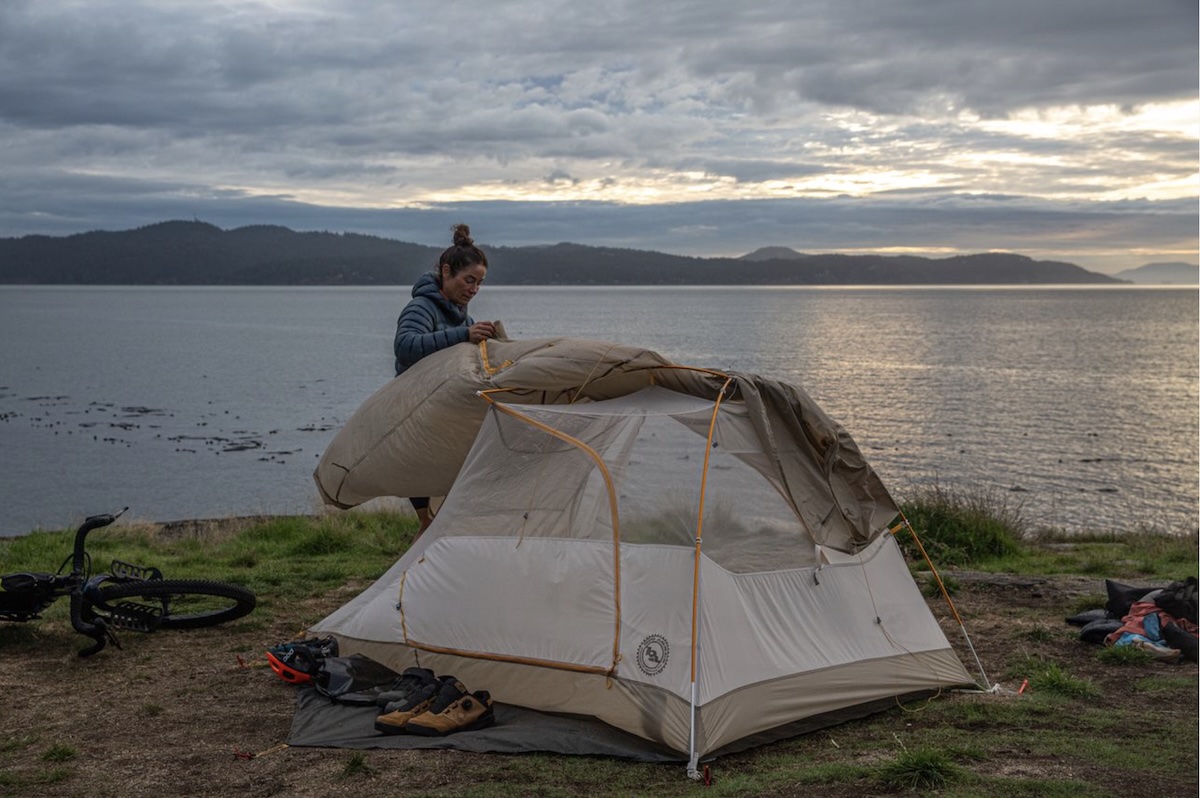
Rain
My partner and I hunkered down in a torrential downpour during our first night in the Tiger Wall Bikepack and came away dry and warm. The tent provided excellent protection from the rain, with both the fly and floor using silicone-treated nylon ripstop with a 1,200-millimeter water-resistant polyurethane coating. The storm also allowed us to practice erecting the tent under time pressure, though the amount of time we spent stuck inside made us realize we'd like more interior space (this tent is also available in a 3-person version). Overall, we have always loved Big Agnes’ weather protection—the water beads off the material, and we've never experienced the fabric wetting out. This version performed just as we trusted it would.
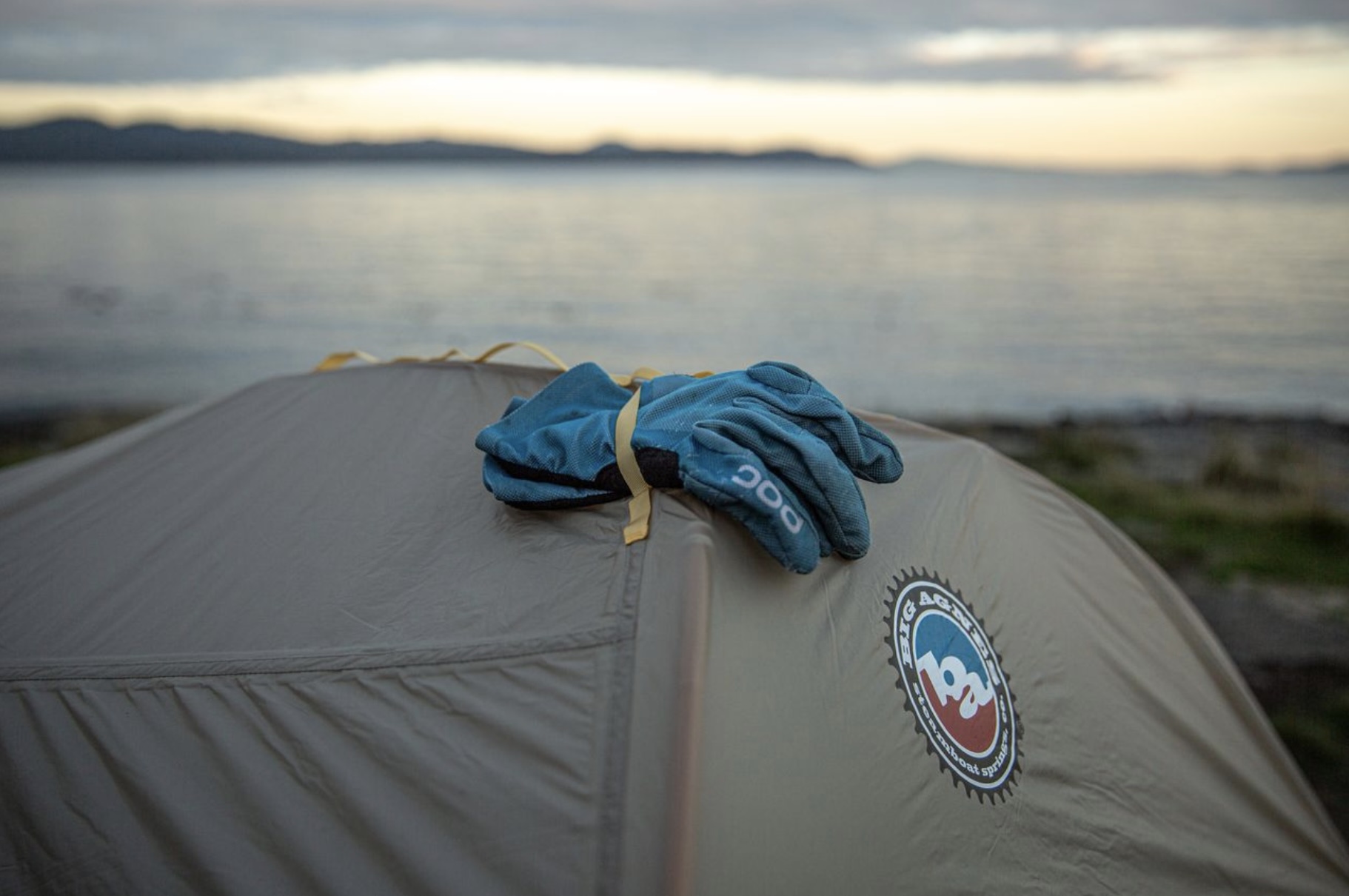
As with most two-person tents, the Big Agnes Tiger Wall UL2 Bikepack would be ideal for a single person (or one person and dog), but the two of us were nonetheless comfortable enough for a few nights. The 28 square feet of interior space is the same as the original Tiger Wall UL2 (the non-bikepack version), with identical tapered dimensions. It's slightly smaller than the 29-square-foot MSR Hubba Hubba 2 Bikepack, and while the single square foot of space might seem minimal, the Tiger Wall feels quite a bit smaller thanks to the steeply tapered ceiling. Our two single Therm-a-Rest NeoAir Xlite NXT sleeping pads barely fit side by side, and we were not able to store much gear inside the tent. That said, we did have enough space to keep camera equipment and clothes by our feet and then stashed lighter items in the array of interior pockets.

The two 8-square-foot vestibules allowed us to store our bike bags, cook sets, and shoes, and, as mentioned, the extended footprint added protection from damp ground. At its highest point, the ceiling is 39 inches (a noticeable 3 inches shorter than the Hubba Hubba). The side walls taper steeply from the peak, and the whole tent tapers down towards the feet. My partner is six feet tall and found the ceiling tapered so much that he couldn't lie on his back with his feet pointing up. The floor space is also tapered to save room at the foot of the tent, which means it's not designed for head-to-toe sleeping. We appreciate the dual side-entry doors though, which make it easy to enter/exit without disturbing the other person and allow you to use a door away from wind and rain.
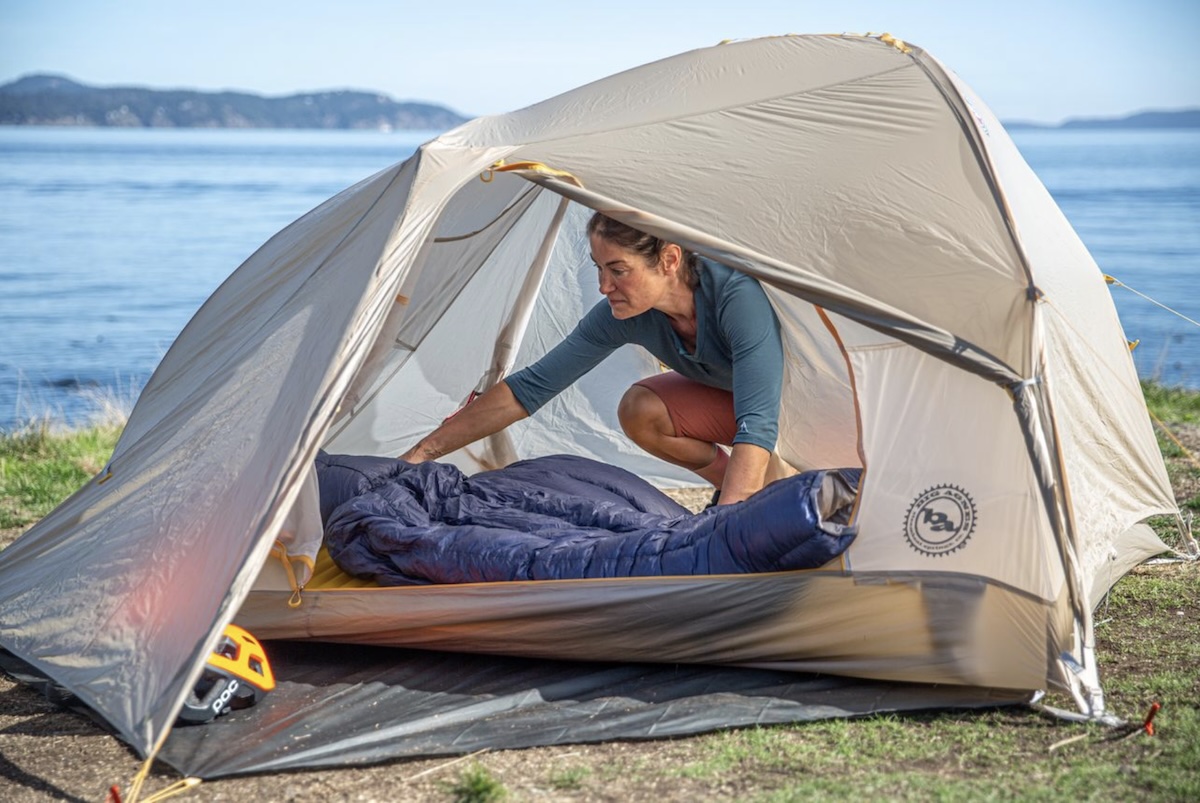
Big Agnes did an impressive job with the gear storage pockets on the Tiger Wall Bikepack, which helps increase the livability as it allows gear to be inside without taking up floor space. We used the large, shelf-like pocket above the foot area to stuff hats, sunglasses, and headlamps. The ceiling pocket is perfect for extra layers, and the media pocket above our heads held our phones and inReach. The outside of the tent features a strap for holding helmets, but we found it a bit awkward and unnecessary, and we typically kept our helmets in the tent so critters weren't tempted to chew on them. Finally, the fly has built-in webbing loops for drying damp gear. We found it easy to shove clothing and gloves into these straps, though we wouldn't leave anything there overnight.
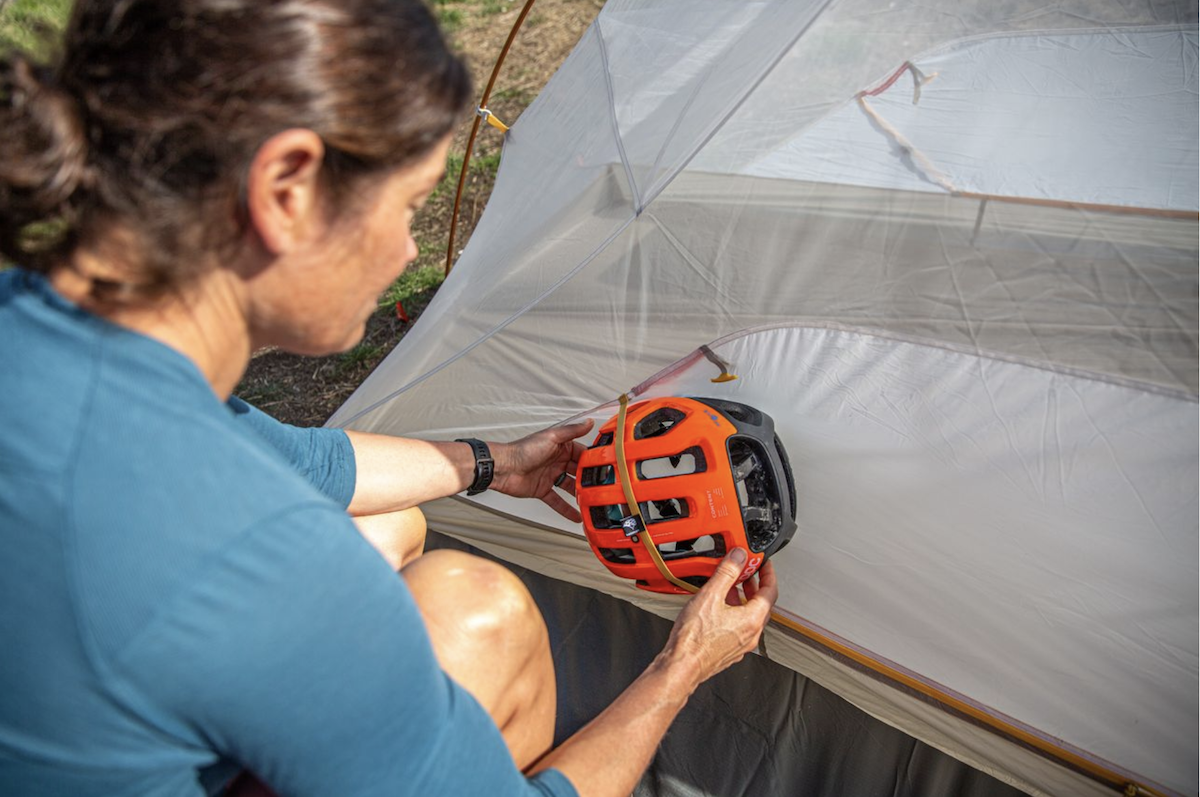
The Tiger Wall UL bikepack weighs 2 pounds 15 ounces all in, which isn't the lightest 2-person tent out there, but still undercuts the MSR Hubba Hubba Bikepack by an impressive 13 ounces. It is heavier than the original Tiger Wall UL2, which weighs 2 pounds 8 ounces, thanks to a simpler pole system, fewer accessory loops, and a minimalist stuff sack. The Tiger Wall Bikepack's burly stuff sack doubles as a bike bag and adds weight, so unless you're planning mostly bikepacking trips and need these extra features, the original, lighter Tiger Wall might be a better option. That said, we tend to be more concerned with packability and livable space while bikepacking, and the sub-3-pound weight didn't feel like a burden on our bikes.
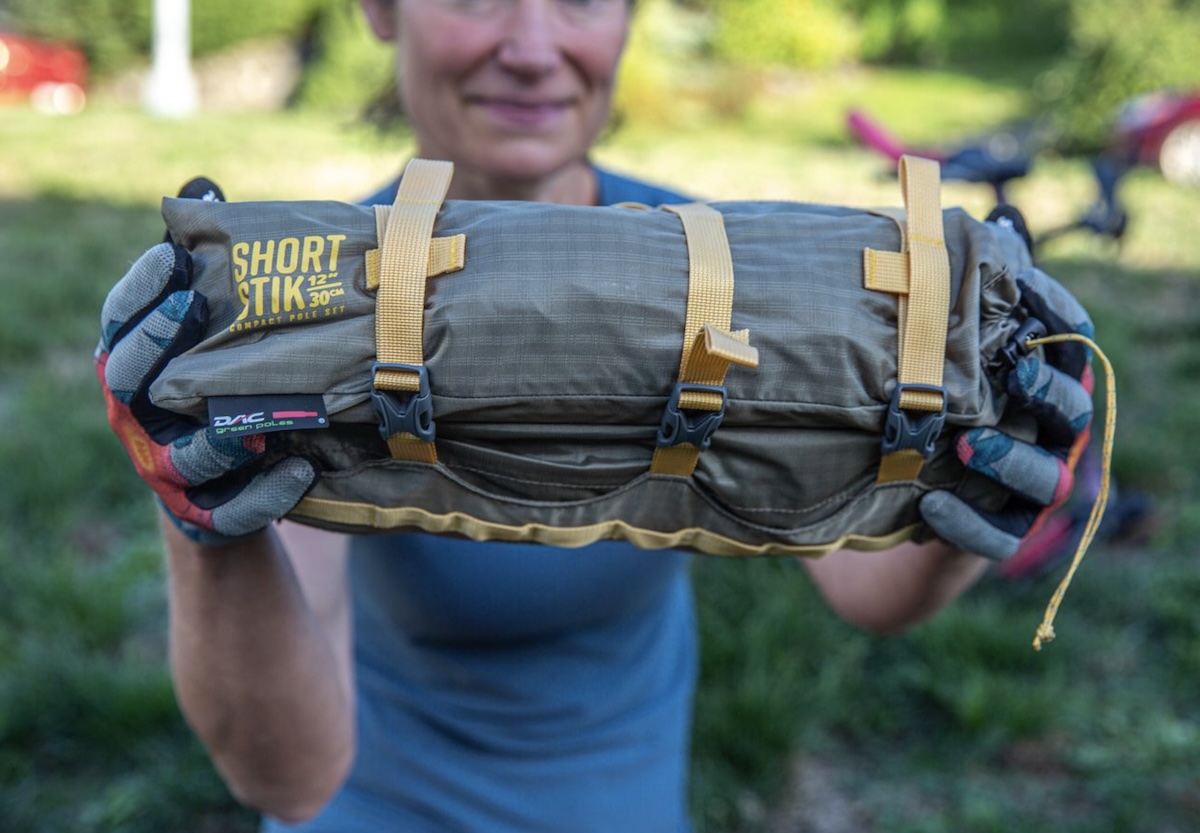
Though the Tiger Wall UL2 Bikepack is decently lightweight, we didn't find the fly material or tent body mesh to feel overly vulnerable, especially compared to the more fragile-feeling Nemo Hornet Elite OSMO tent we tested earlier this year. We've ripped a few tents and have learned that bike cleats are not kind to tent floors, so be careful with bike shoes if you ride clipless. The burly handlebar bag will add longevity to the tent, as long as it's securely stored, and the 12” DAC Featherlite NSL poles have held up admirably to wind gusts and general set-up/tear down use.
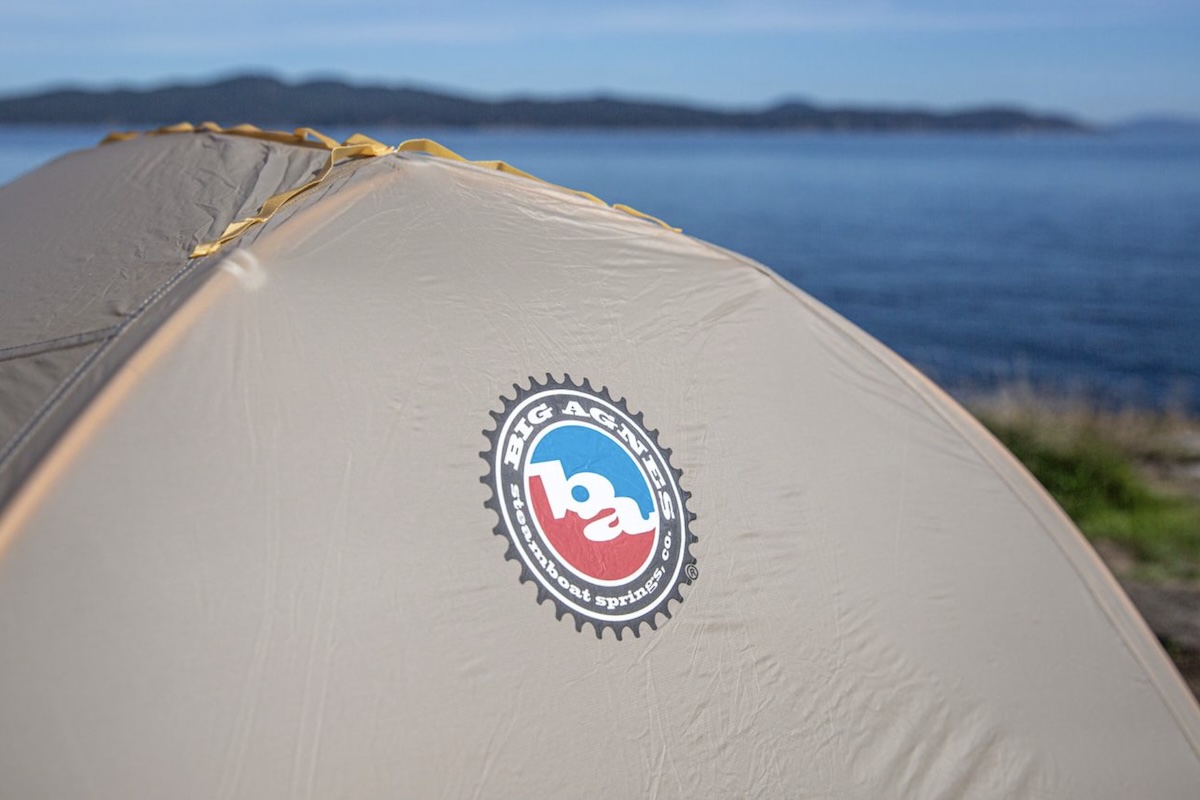
The Tiger Wall UL2 Bikepack has nylon siding along the walls, which is helpful for reducing drafts but also slightly reduces ventilation. Any significant amounts of condensation we experienced came on evenings camping along the ocean with high humidity, but it's hard to imagine any tent remaining dry in those scenarios. Even with the high humidity, the inside of the tent and our sleeping bags remained dry, and the tent also dried incredibly quickly in the sun. There is ample venting under the fly as well which helps encourage airflow regardless of the weather.
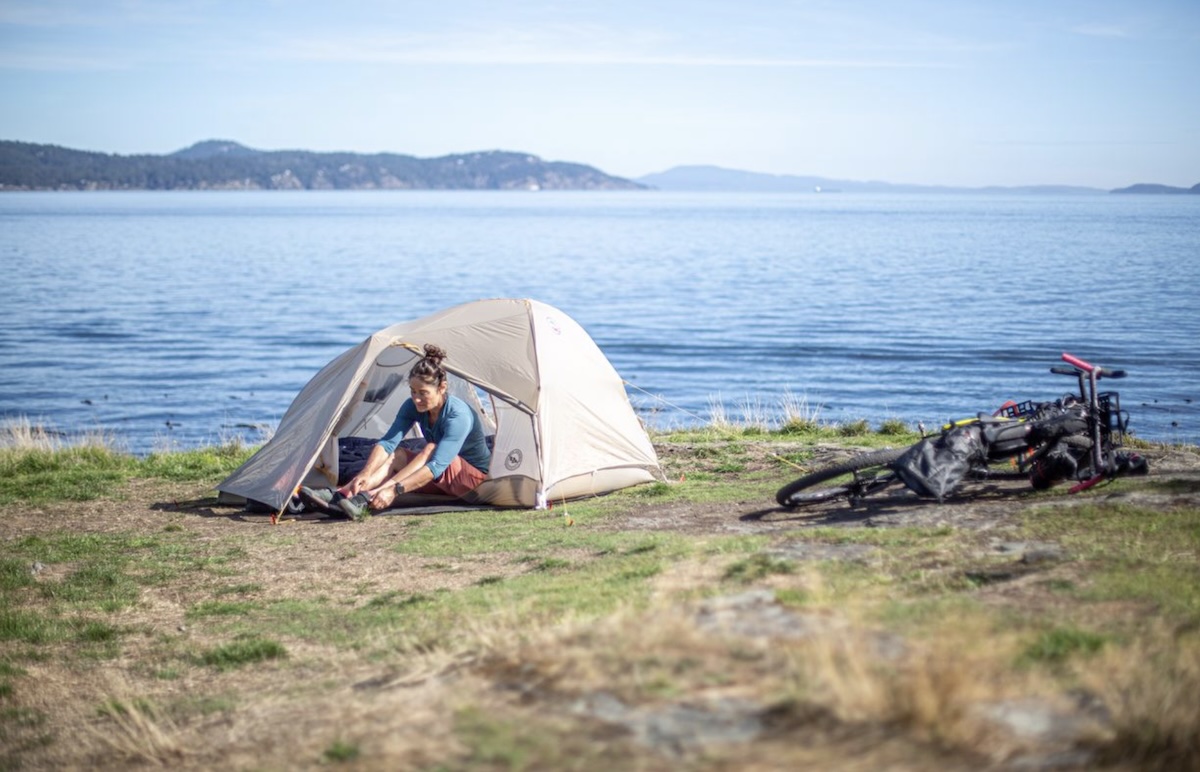
Handlebar Bag
The Tiger Wall's stuffsack doubles as a heavy-duty bag designed to be attached to bike handlebars. We actually prefer to leave the bag behind, separating the tent and poles into our frame bags. The Tiger Wall is small enough that it can fit in my 3.35L Salsa Anything Cage fork bag, which is more convenient than taking up the whole handlebar roll—plus we save 3.4oz by ditching the tent bag. If you do choose the use the bag, keep in mind it doesn't have bar-specific spacers like the Hubba Hubba system. Instead, the built-in straps attach the bag to the handlebars, which helps prevent bouncing, but the flush design leaves minimal space for the hands. We appreciate the extra daisy chains for attaching gear, but since we already use the Revelate Sweet Roll, we usually opt to put the tent in our other frame bags.
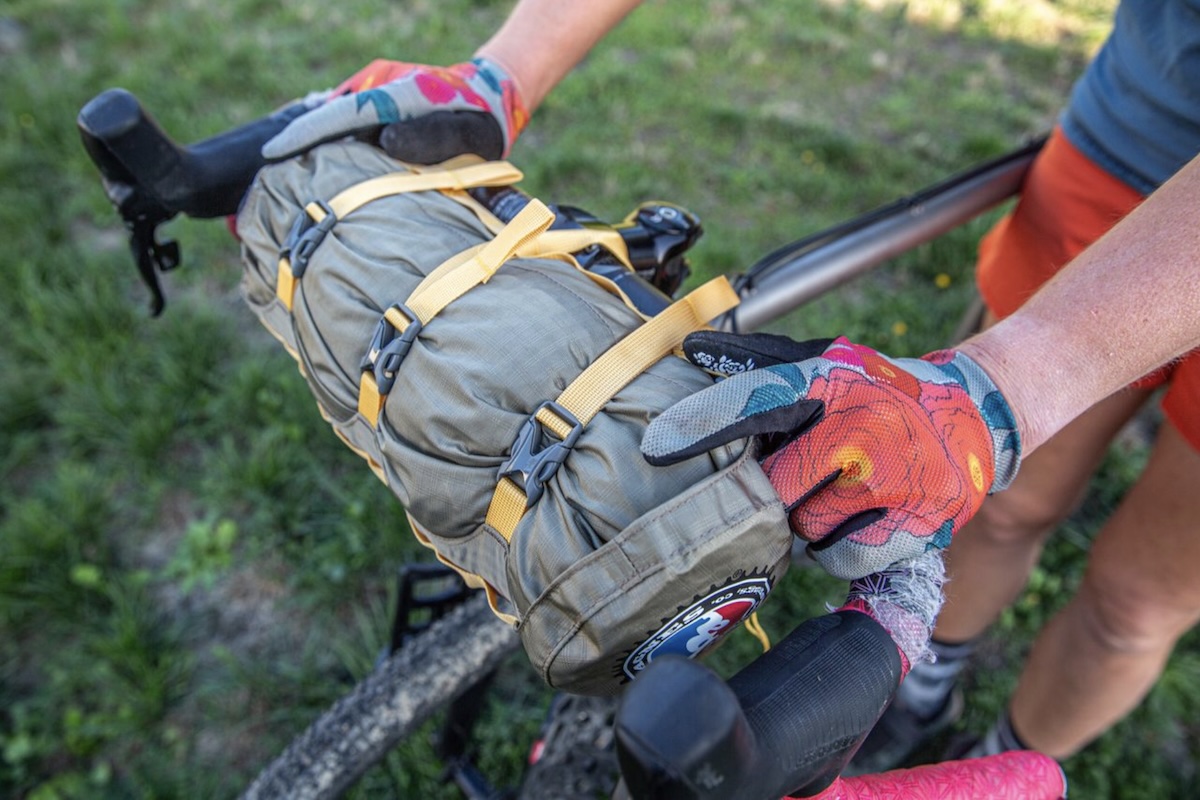
Shorter Poles
Like other Big Agnes bikepacking tents, the Tiger Wall Bikepack's poles utilize the "ShortStik" design, breaking down to 12-inch segments so you can easily fit them on your handlebars or in other bike bags. We’ve used this tent in pretty decent winds, and the shorter poles don’t seem to compromise the integrity or strength of the poles. The extra segments do take a few moments longer to snap together, but the convenience of the shorter poles is well worth it for bike-specific use.
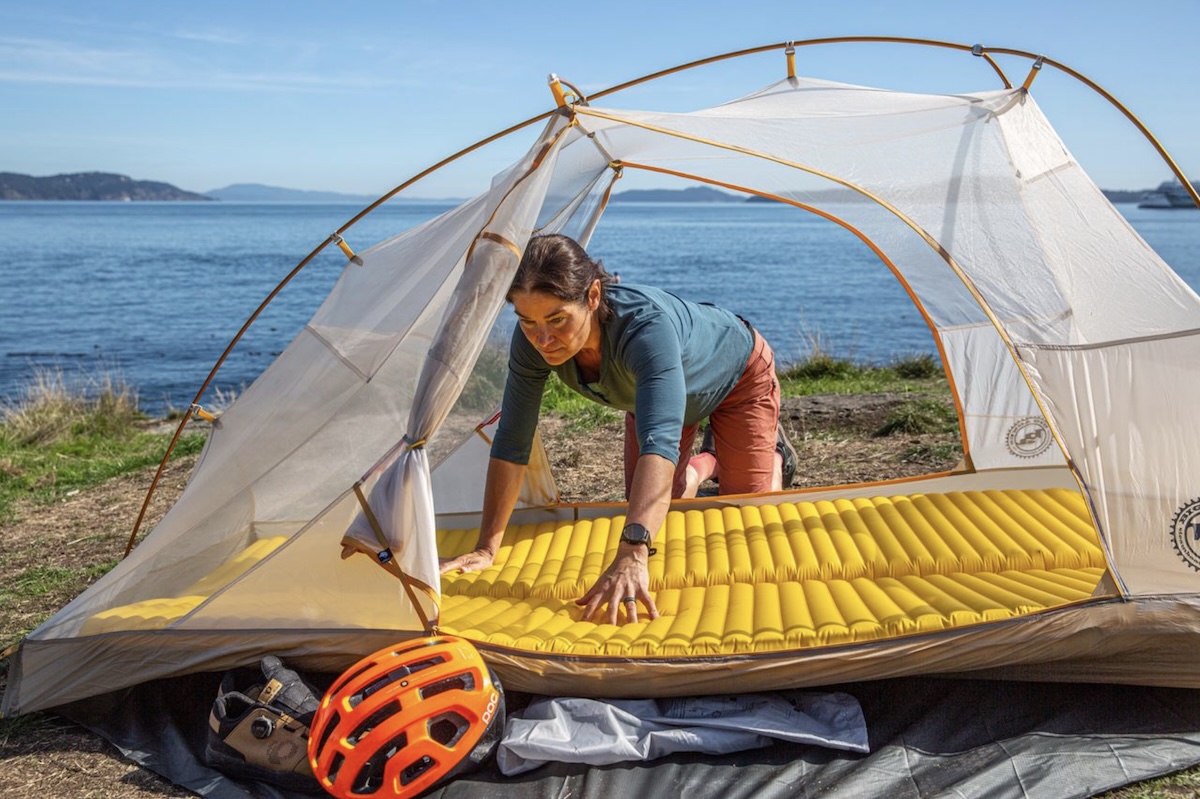
Like the original Tiger Wall UL2, the bikepacking version is semi-freestanding. This means the foot of the tent requires staking, and the pole system has a single anchor at the foot instead of all corners staked out. We often pitch our tent on rocky slabs, making it difficult or impossible to stake and forcing us to rely on large rocks to hold the corners in place. The search for rocks has taken significant time, so we usually prefer a free-standing tent. For those in better staking areas, the Tiger Wall comes with 9 “dirt digger” stakes. Like most ultralight stakes we’ve used, they are prone to bending when used in hard or rocky areas, so be careful when slamming them into the ground.
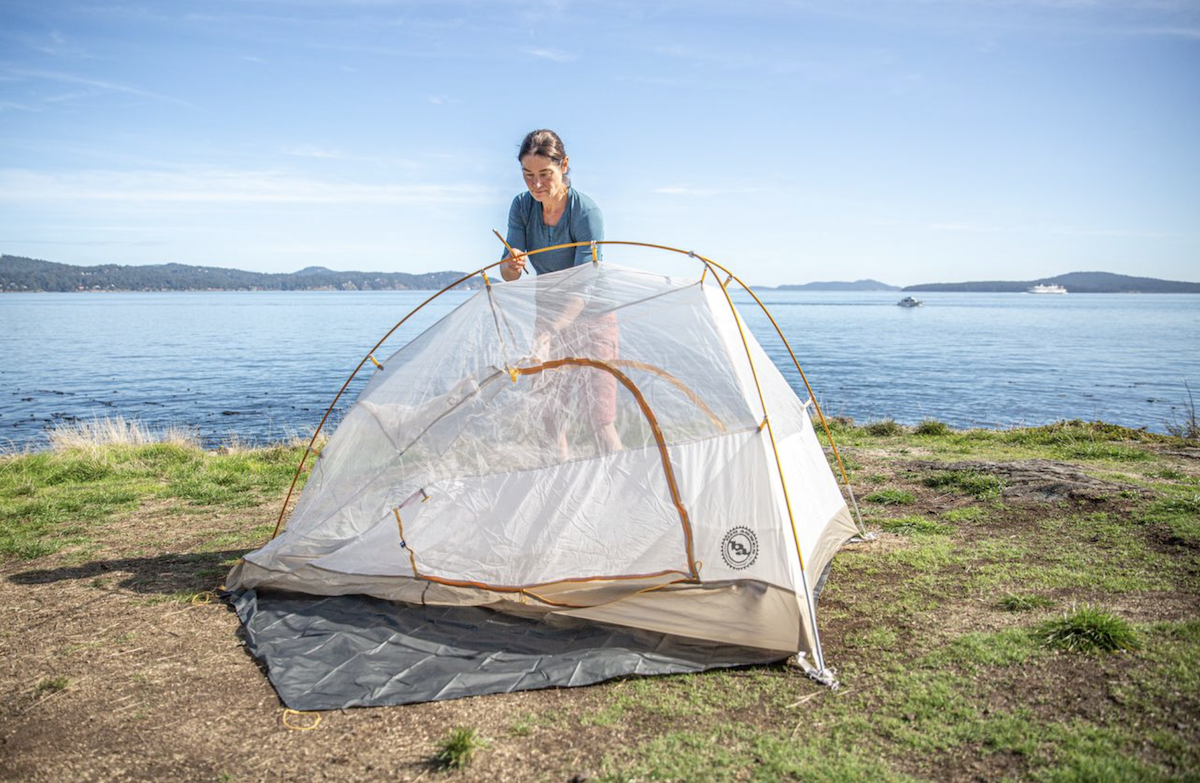
The Tiger Wall's set-up is incredibly intuitive, making it easy to erect the tent in a hurry as the sun is setting or rain is coming in. The poles have a single hub where the three long sections come together—two sections extend to the head, with the afore-mentioned single section at the foot. The poles are color-coded, though this isn't totally necessary with a three-section design. Once inserted into the tent anchor points, the poles create the frame from which the tent body hangs via plastic hooks. This is a pretty standard semi-freestanding design, and can be pitched in just a few minutes.
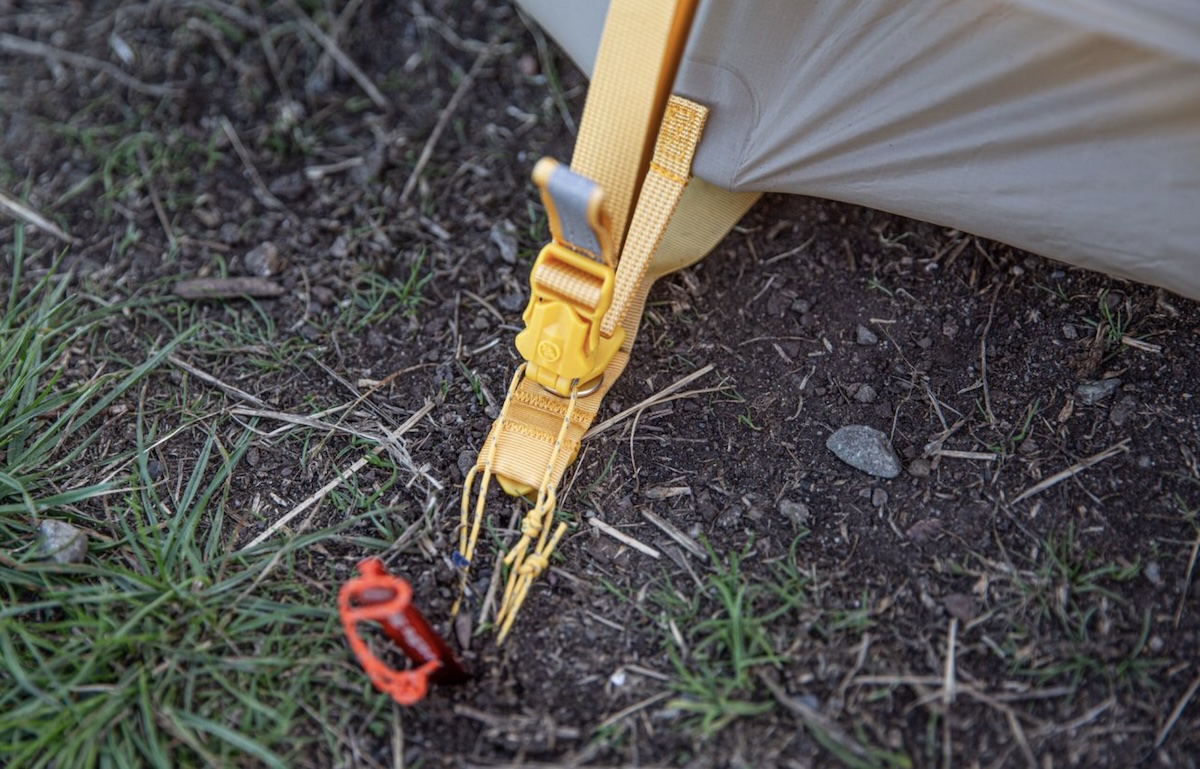
The Tiger Wall uses Big Agnes’s proprietary tent corner construction, which includes TipLok Tent Buckles. Just insert the pole tip in the grommet, then buckle the rainfly in place before tensioning. Finally, the Tiger Wall Bikepack comes with a horizontal spreader bar to increase head room. It slides easily into place above the tent doors and keeps the ceiling taut.
The Tiger Wall UL2 bikepacking tent also comes in a 3-person bikepacking version. For just 6 more ounces and an additional $50, you gain 3 inches of head height and 10 square feet of interior space. In retrospect, this would likely be a better option for me and my partner. We backpacked with the Tiger Wall UL3 in Peru and found it to be spacious, and sizing up in capacity is often a better option for long trips. You can also grab the non-bikepack 2-person Tiger Wall (2 lb. 8 oz. with 28 sq. ft. of space for $480) or the 3-person (2 lb. 10. oz. with 38 sq. ft. of interior space for $529). The original one-person Tiger Wall is also available, weighing 2 lb. 2 oz. with 19 square feet of interior space for $430. Finally, ultralighters might opt for the Tiger Wall 3 Platinum for $700. This version uses a super thin 7-denier ripstop nylon and weighs just 2 pounds 9 ounces with 38 feet of interior space.
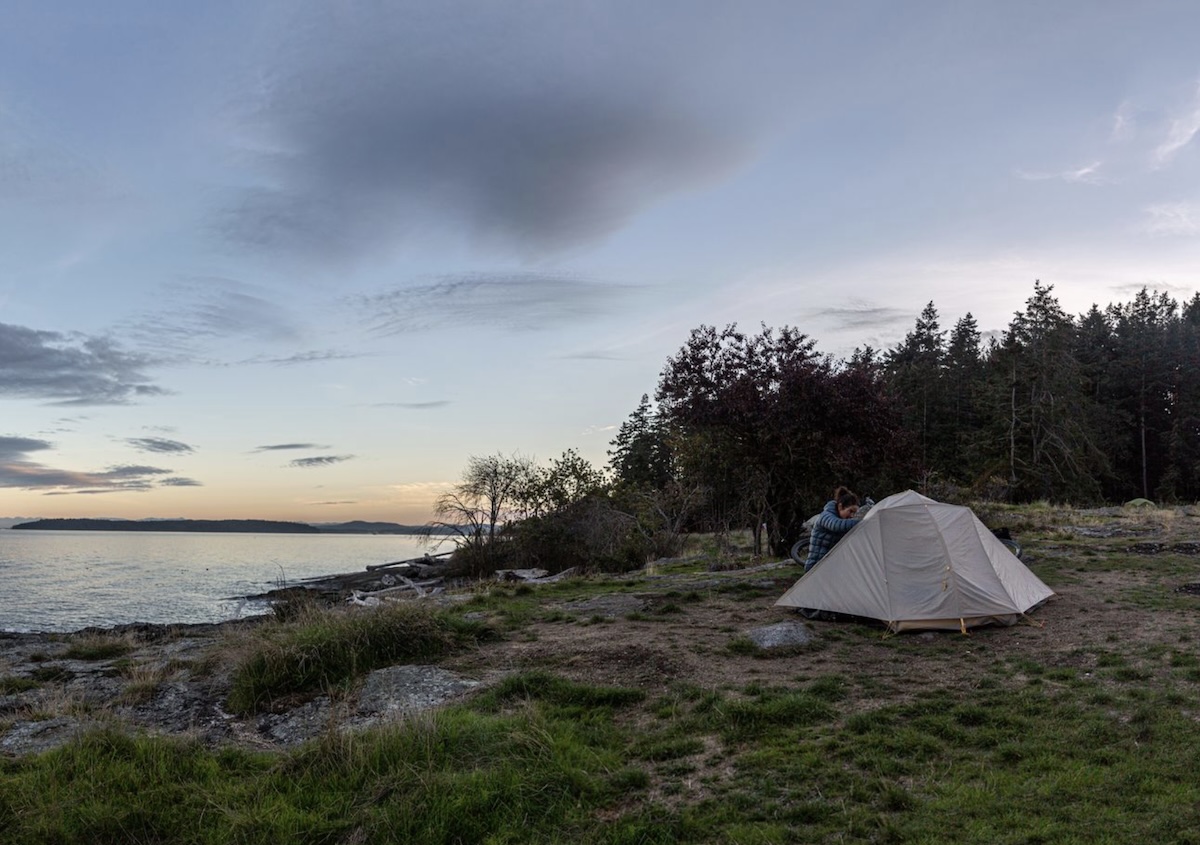
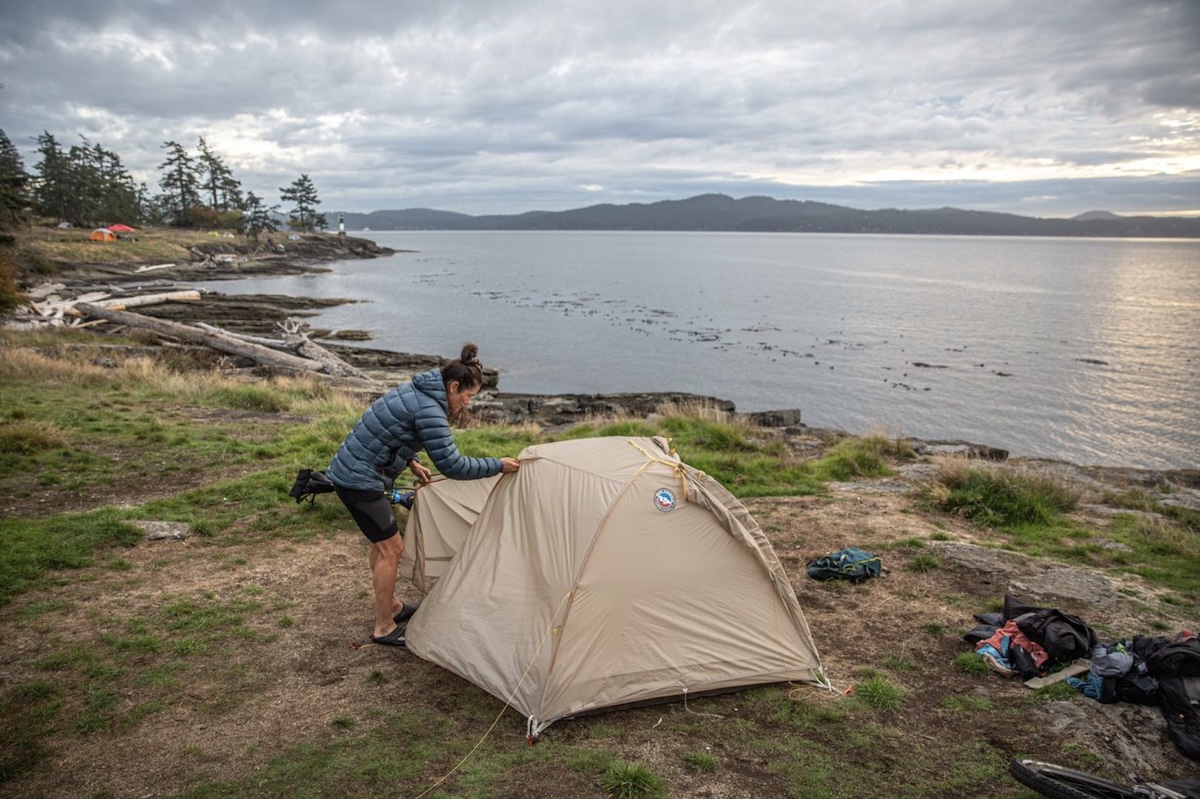
| Tent | Price | Weight | Floor Area | Height | Vestibule Area | Doors |
|---|---|---|---|---|---|---|
| Big Agnes Tiger Wall UL2 Bikepack | $500 | 2 lb. 15 oz. | 28 sq. ft. | 39 in. | 16 sq. ft. | 2 |
| Big Agnes Copper Spur HV UL2 Bikepack | $580 | 3 lb. 8 oz. | 29 sq. ft. | 40 in. | 18 sq. ft. | 2 |
| MSR Hubba Hubba Bikepack 2 | $580 | 3 lb. 12 oz. | 29 sq. ft. | 42 in. | 17 sq. ft. | 2 |
| Big Agnes Tiger Wall UL2 | $480 | 2 lb. 8 oz. | 28 sq. ft. | 39 in. | 16 sq. ft. | 2 |
The Big Agnes Tiger Wall UL2 Bikepack is a packable, lightweight tent with several tailor-made bikepacking features. The brand also offers their popular Copper Spur UL2 in a bikepacking version, which also comes with the 12-inch ShortStik pole set and additional daisy chain webbing on the fly. The Copper Spur adds an extra square foot of interior space compared to the Tiger Wall, and all four corners can be staked, which can make it more versatile for camping on hard surfaces. You'll pay $80 more and carry an additional 9 ounces for the Copper Spur Bikepack though, so it's a tradeoff for the space and design.
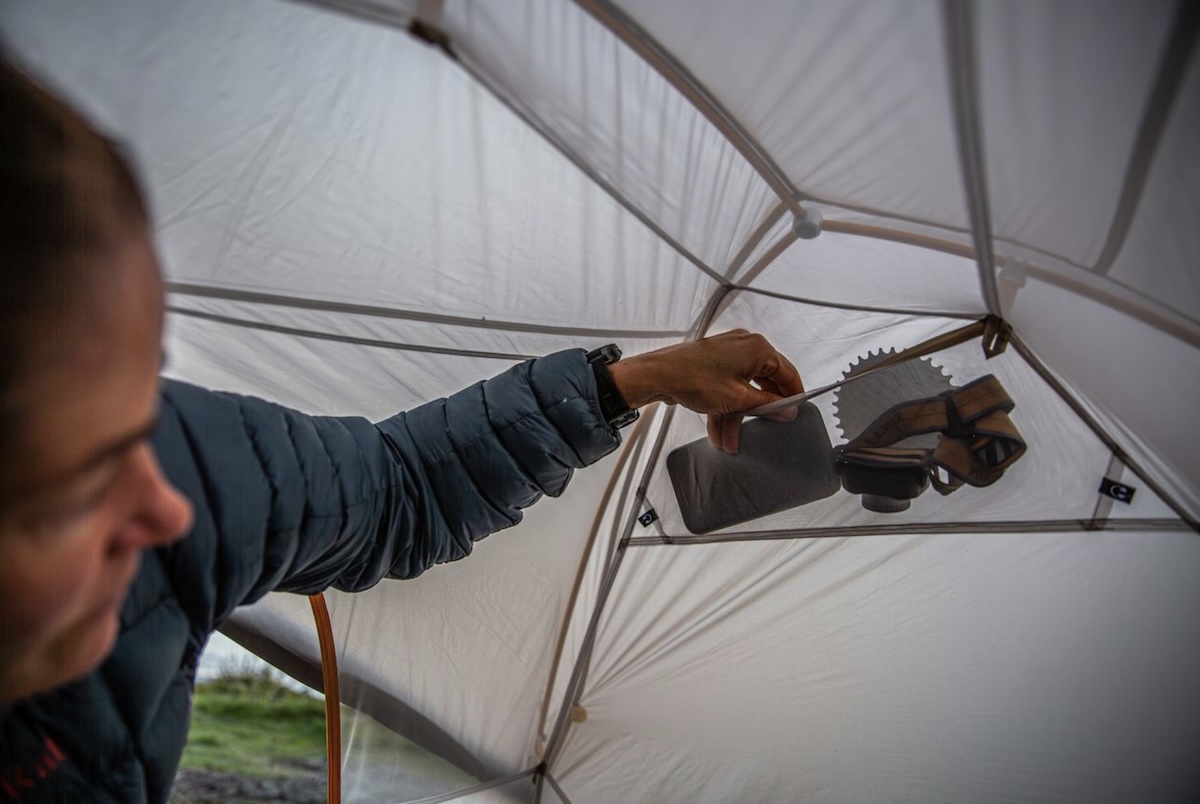
We've also tested the MSR Hubba Hubba Bikepack, which is $80 more than the Tiger Wall and has 29 feet of interior space with slightly larger vestibules. We appreciated the extra 3 inches of headroom in the Hubba Hubba, as well as the fully freestanding design. This is the heaviest tent on our comparison list though, and at 3 pounds 12 ounces, is edging away from a true lightweight model. Finally, we have to compare the original Big Agnes Tiger Wall UL2 to the bikepacking version. The original Tiger Wall has the same dimensions and design as the bikepacking version, but you save 7 ounces and $20. This might be the better option for anyone using this tent for both bikepacking and backpacking. It's compact enough to fit in frame bags (especially split between two people) so you won't miss the included handlebar-bag-stuffsack, and while you lose the 12-inch pole sections, we've been able to strap the longer poles to our top tube with no issues.
Back to the Big Agnes Tiger Wall UL2 Bikepack Review See Our Backpacking Tent Guide